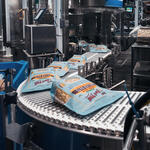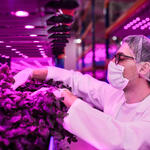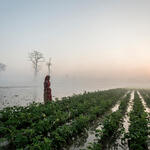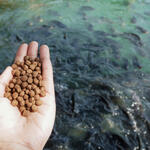- Date: 20 December 2022
If you’re baking this holiday season, you’re likely doing the best you can to make the most of your ingredients and waste less. But it’s not just up to consumers to do their part; minimizing food waste must be a priority throughout the entire supply chain. And some companies are already rising to that challenge.
Bob’s Red Mill partnered with the Pacific Waste Food Waste Commitment, along with TripleWin Advisory, to develop an employee engagement campaign to reduce food waste in their whole grain milling and packaging facility in Milwaukie, Oregon. The details of the campaign and its results are available in a new case study here.
We caught up with Julia Person, Sustainability Manager at Bob’s Red Mill, to discuss lessons from the campaign and how and why the company is working to address food waste.

Julia Person, Sustainability Manager at Bob's Red Mill
Why is addressing food waste a priority for Bob’s Red Mill?
We’re proud to be the first manufacturer to sign onto the Pacific Coast Food Waste Commitment to collaboratively cut food waste in half by 2030, and we hope to lead the way for other companies in the Pacific Northwest. This issue is a priority for two different reasons: we know preventing food waste can help fight climate change and stop hunger, and it also makes our business more efficient and profitable. As an employee-owned company, our profits are shared with the entire team. That’s a powerful incentive for us all to work together to prevent food waste. But it’s also a natural outgrowth of our core values of Respect, Teamwork, Accountability and Determination.
- Date: 14 December 2022
- Author: Julia Kurnik, Director, Innovation Startups, WWF Markets Institute
Food production is the largest human impact on the planet. It contributes to habitat conversion, greenhouse gas (GHG) emissions, soil degradation, agrochemical run-off, and inefficient water use. World Wildlife Fund (WWF) envisions a more distributed and resilient food system in which some food is produced at scale closer to consumers, with more efficient use of inputs, less waste, and a lower carbon footprint. Soilless indoor farming could help get us closer, especially if paired with energy and site innovations, community integration, and knowledge sharing. To that end, WWF embarked on a project to better understand the challenges of this growing industry and develop practical solutions.
- Date: 08 December 2022
- Author: Melissa D. Ho, Senior Vice President, Freshwater and Food
Transforming our food systems is critical if the planet is to meet our ambitious and necessary goals for climate, nature, and people. How we produce and consume food will determine the future of humanity. Science clearly states that agricultural production contributes over a quarter of greenhouse gas emissions and is the major driver of biodiversity loss and the degradation of soil and water globally. We neglect these impacts at our own peril because food production for future generations depends on what we do now to ensure healthy ecosystems and a stable climate. While the dual crises of climate and biodiversity loss are inseparable, so too are the solutions and it is here where agriculture has a critical role to play.
- Date: 23 November 2022
- Author: Sheila Bonini, Senior Vice President, Private Sector Engagement
Having just returned from COP27 in Egypt, I would like to share my reflections on the state of the climate dialogue. Food was back on the agenda this year in a major way. It’s an area where business can support solutions around sustainable agriculture, resilience, and land-use change. And while there was some progress overall at COP27, including a welcome step towards a loss and damage fund to help vulnerable countries hit hard by climate disasters, my biggest takeaway is that climate actions aren’t moving quickly enough.
Climate change could depress growth in global agriculture yields up to 30% by 2050. At COP27, we introduced, It’s Time: Solving the Great Food Puzzle for a 1.5° C Future, A WWF Food Manifesto. It calls for food-based climate action pledges to be implemented at the national and regional levels and identifies five decisive actions central to doing so. You can read about these actions here.
Without resilient agriculture, crop failures and food insecurity will likely lead to increased environmental degradation as agriculture shifts to new locations and communities exploit natural resources to accommodate lost livelihoods and incomes. This challenge is particularly acute in Africa.
WWF recently launched, Scaling and Accelerating Adaption in Food Systems in Africa, a report that assessed Nationally Determined Contributions (NDCs) and National Adaptation Plans (NAPs). It found that adaptation plans must be broadened to include shifts to healthier and more sustainable diets combined with radical cuts in food loss and waste alongside improved food production. Only by adopting full food systems approaches, from farm to fork, can we achieve food security and a stable climate. African countries must set more ambitious targets, but finance must also be allocated to the continent and channeled to the local communities that will implement solutions.
By narrowly focusing only on agricultural production, negotiations failed to deliver a transformative plan on food. Nature is humanity’s first line of defense against the impacts of climate change, but climate change itself poses an immediate and existential threat to our natural ecosystems –on which our food systems rely. Ecosystem services, such as pollination of crops, water filtration, flood mitigation, waste decomposition, carbon sequestration and climate regulation are worth approximately $125 trillion dollars annually, providing valuable economic benefits to agriculture, society and business. These economic externalities and system dynamics need to be reflected in policy and finance. There is still hope though that with a joint working group on agriculture and food security over the next four years, it is possible to increase the ambition and build a more holistic approach. Read more on WWF’s hopes for the work ahead here, as well as a joint open letter to negotiators and ministers from 100 organizations urging for more ambitious action to accelerate the transition to more equitable and sustainable food systems.
As U.S. Special Presidential Envoy for Climate John Kerry so eloquently stated in the run-up to Sharm el-Sheikh about the fight against climate change: “it’s not just the work of one government, or public or private sector, bilateral or multilateral. There’s only one way to secure the future. We have to summon the greatest effort we’ve ever assembled, with the greatest sense of urgency. And we must win this fight, because the alternative is beyond unacceptable.”
Unfortunately, a disappointing roadmap was released by 14 of the world’s largest agricultural companies to address deforestation associated with palm, beef, and soy production in biomes around the world. While the roadmap demonstrates progress for some commodities, it represents a step back for others and ultimately falls short of the 1.5° C pathway that was promised at last year’s COP. There’s a clear path for agricultural companies to shift food production to degraded land.
This message was sent by the newly elected Brazilian President, Lula da Silva, in his address at COP where he stated, “I am sure that Brazilian agri-business will be a strategic ally in our government looking for regenerative and sustainable agriculture. We have 30m hectares of degraded lands. We don’t need to deforest one square meter to be one of the largest food producers in the world.” And while a more sustainable agricultural model is a good step, nature-based solutions also need to be part of the equation.
We have the opportunity to invest in nature to mitigate the worst effects of climate change as well as be prepared for changes that threaten our ecosystems and our economies. Using land for farming and conserving and restoring nature’s ability to provide multiple benefits, resources, and services is not mutually exclusive. As Secretary Kerry so adeptly noted, “the alternative is beyond unacceptable.”
For more on WWF’s take-aways from COP27, see our closing press release here.
- Date: 15 November 2022
- Author: Yvette Cabrera (NRDC) and Pete Pearson (WWF)
COP27 (the 27th meeting of the Conference of Parties to the international climate convention) is underway and we face the stark realization that we are missing our climate targets globally.
But there is hope. Food loss and waste (FLW) are significant contributors to human-caused greenhouse gas (GHG) emissions, responsible for 8-10% of emissions globally. Reducing FLW alone can cut methane emissions by up to 15%, which is half of the Global Methane Pledge of 30% reduction by 2030. To drive down emissions and keep global warming below the critical 1.5ºC, food loss and waste reduction is a top climate solution that must be accounted for in countries’ Nationally Determined Commitments (NDCs) towards the Paris Climate Agreement.
- Date: 26 October 2022
Despite the period of historic drought that has crippled parts of the Northern Great Plains (NGP) over the past two years, during the spring of 2022, WWF and Air Wick’s One Square Foot (OSF) initiative reseeded 2,961 acres of marginal cropland back to native grasses and forbs totaling 128,981,160 square feet.
The goal of this three-year collaborative initiative is to restore a minimum of 1 billion square feet (approximately 23 thousand acres) of previously plowed grassland back to thriving prairie for wildlife, pollinators, and sustainable ranching operations.
Although historic levels of drought forced some scaling back of the planned rate of reseeding, by closely monitoring weather trends, and planting in areas where precipitation patterns were favorable and chances of reseeding were relatively high, the project was able to make headway. Grassland ecosystems are highly complex and there is still much to discover about their restoration and conservation. In a sense, grasslands can be compared to forests, but on a smaller scale. Restoration takes time and patience.
Joe Russell, who manages the Veebaray Cattle Company 30 miles west of Sydney, Montana, was one of the first ranchers to participate in OSF. In the fall of 2021, 235 acres of marginal cropland on the ranch were reseeded back to grassland.
This past summer, the first signs of real grassland recovery began to show, with bright yellow prairie coneflowers—great food plants for seed-eating birds and native pollinators—dotting the formerly plowed field. Grassland ecosystems can take years to recover in the best of years, so to see the land respond so quickly to the reseeding effort is promising.
- Date: 25 October 2022
- Author: Katherine Devine and Leigh Prezkop, WWF
There has been a perfect storm of issues circulating - covid, climate change, and the war in Ukraine, each of which has a significant impact on our food system. The impact of the conflict in Ukraine is expected to continue to push food prices upward. Globally, as major exports are stuck in fields and ports in Ukraine and Russia coupled with rising fertilizer and fuel prices, food prices remain high. Some estimates suggest that each month of conflict will lead to a year of turmoil. We are at six months and counting.
World Wildlife Fund (WWF) published No Grain Left Behind, a report that revealed that the average post-harvest loss for corn and soybeans in the US is higher than both grower estimates, and extension accepted levels. This scale of potential loss shows how vital it is to work towards more consistent, accurate, and global measurements of post-harvest loss. The average in-field corn loss on US farms (not including on-farm storage) is about 4.7%, whereas anticipated industry levels were 1%. When scaled to the national level, this is about 503 million bushels of corn worth $2.07 billion, based on 2019 production figures. For soybeans, about 4.5% is loss in-field, whereas 3% is the anticipated industry loss. With the scale of US commodity production, the level of corn loss alone found in this study when scaled to national levels was nearly equivalent to the total 2021 corn exports to Mexico, the second largest buyer of US corn for that year.
- Date: 16 October 2022
- Author: Pete Pearson, Global Initiative Lead — Food Waste
I have a confession: I want to leave my current job by 2030. That is the date the world has set to realize a 50% reduction in food waste.
Working for the world’s largest conservation organization on some of the biggest issues that will define our future, including the future of my own children, seems like something most people would be excited about. But the truth is, I wonder each day why it’s so difficult to get the world committed to ending food waste.
Of all the nature and climate solutions we debate, I’d contend that reducing food loss and waste is the least contentious. There are so many benefits: it can measurably reduce carbon and methane emissions; it could ease pressure on land and water ecosystems used for food production; it helps alleviate global food insecurity and hunger. Yet there is not wide scale global adoption of food waste reduction as part of climate commitments. To date, only 38 governments have food loss and waste reduction as part of their national climate goals. Why so few?
- Date: 10 June 2022
- Author: Julia Kurnik, World Wildlife Fund
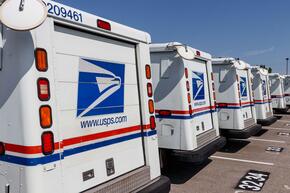
Our current food system is failing farmers, consumers, and the environment. Many farmers, especially small and minority farmers, struggle to turn a profit due to long supply chains. Meanwhile, over 30 million Americans experience food insecurity and often lack access to fresh, affordable produce. Yet fruit and vegetable farms exist in the majority of US counties, and up to 50% of all produce is wasted. There has to be a better way to get food from farmers to families.
Farmers Post is a program proposed by WWF’s Markets Institute as a way to connect farmers directly with consumers and increase food access, convenience, and nutrition. Through a partnership with the United States Postal Service (USPS), Farmers Post would allow customers to order produce from local farms and get it shipped right to their doorsteps. These are the top five reasons why Farmers Post would contribute to a more sustainable and equitable food system.
- Date: 03 May 2022
- Author: Katherine Devine, Director of Business Case Development, WWF
Animal nutrition is one of the leading contributors to greenhouse gas (GHG) emissions in the food sector, mainly due to deforestation and land conversion, whereby habitats are turned into farmland or rangeland. Nutreco, a leading manufacturer of both aquaculture and livestock feed, is taking innovative action to reduce its environmental impact by 2025. Its RoadMap 2025 outlines the company’s ambitious set of goals that address health and welfare, climate and circularity, and good citizenship.
WWF recently developed a business brief to examine Nutreco's plan and see what lessons could be applicable to the entire feed industry. The goal-setting process for RoadMap 2025 involved engaging stakeholders, including the staff who carry out essential business functions and external partners like suppliers and customers. These stakeholders provided input that fed into the RoadMap’s three pillars, each of which contains key priorities and an action plan for accomplishing them.
